9 Best Vocal Microphones to Make Your Vocals Sound Amazing!
Some sounds, musical or not, are as profoundly accustomed to the human ear as the human voice itself. When recording vocals with any intention, catching a realistic and first-class sound is crucial to decoding this familiarity, and doing so requires a microphone that efficiently duplicates vocal frequencies and dynamic range.
Which are the Best Vocal Microphones for the Studio?
There’s a wide-ranging variety of vocal microphones available on the marketplace today, but when it comes to buying the best vocal microphones for the studio, the choice is entirely personal. At the end of the day, it boils down to the quality of voice it will be captured, or if it will be used in an outdoor setting or a studio. We have compiled a list of the microphones best for usage in studios. Read on for more information on each of them.
- Neumann U 87 Ai
- AKG C414 XLII
- Rode NTK
- Audio-Technica AT4050
- Sennheiser MD421 II
- Beyerdynamic M88 TG
- Shure SM7B
- Electro-Voice RE20
- Blue Baby Bottle SL
1. Neumann U 87 Ai
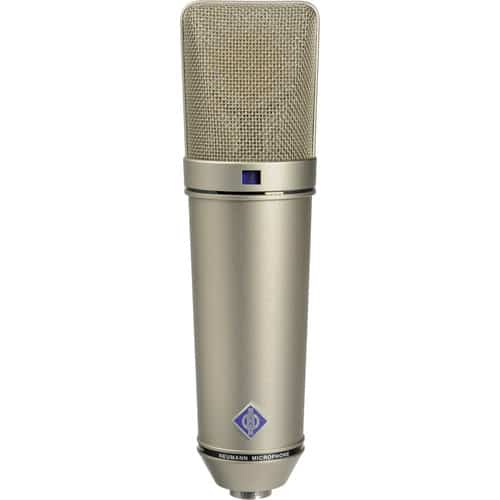
Best Vocal Microphone: Period.
An ultimate legend for years, the Neumann U 87 Ai is a large-diaphragm condenser microphone delivering the eternal and unique sound that remains highly desirable to singers, voice-over artists, producers, announcers, and recording engineers to date.
It was introduced in 1967, and since then, it has fashioned the sound of uncountable hit records. Its tapered build and legendary design have become part of the collective perception of “This is what a studio microphone looks like.”
The perception also stands for the sound; the U 87 Ai signifies studio eminence and has become the gold standard through which other microphones are compared.
The U 87 Ai‘s dual-diaphragm pod, which is elastically suspended, offers the choice of three polar patterns (Omni, cardioid, and figure-8) to boost versatility in the studio. These can be selected with a switch below the head grille.
Furthermore, the mic delivers a switchable -10 dB pad that permits it to capture SPLs up to 127 dB without distortion and a low-cut filter for monitoring the buildup of low-frequency content. Whether it is used for transmission, stage, or studio applications, the U 87 Ai grants a true classic’s coveted appearance, sound, and reputation.
Key Features
- The world’s most famous studio microphone
- Classic sound, instantly recognizable yet versatile
- Omnidirectional, cardioid, figure-8
- Frequency range: 20-20000 Hz
- Balanced frequency response
- Three polar patterns: omni, cardioid, figure-8
- Switchable low cut and pad
- Very low self-noise
- Switchable low-cut filter and -10 dB pad
- XLR 3-pin output
- 48V phantom powered
Conclusion
The U 87 Ai is a studio microphone of matchless clarity. Its natural sound and midrange existence make it the ultimate vocal microphone, admired by singers and engineers alike.
Due to its well-adjusted response in each of its three directional patterns, the U 87 Ai is also a multipurpose microphone for whatever from acoustic guitar to drum overheads.
This mic should be on everyone’s Top Ten list of best vocal microphones.
Price: $3,295 USD
2. AKG C414 XLII

Best Vocal Microphone: For Versatility
The AKG C414 multi-pattern condenser microphone doesn’t need an introduction. A studio and stage beloved for more than 50 years, the C414 has undergone much progress, including additional polar pattern selections and diverse capsule materials.
However, it still holds its well-known transparency and candidness that keeps it a fixed favorite in the mic locker of industry specialists.
Due to its ability to handle numerous diverse sources, it’s been used in some of the world’s top broadcast facilities, performance stages, and recording studios. AKG has boosted the game by adding their C414 XLII, refining the C414‘s already iconic adaptability.
With its nine polar patterns, leading-edge technology, state-of-the-art gears, and reference-quality outcomes, the AKG C414 XLII condenser microphone ushers in a novel standard in microphone resourcefulness.
The C414 XLII has been enhanced by offering a minor presence boost and by providing the three-dimensional reproduction ability of the fabulous AKG C12 microphone. It offers nine pickup patterns, which allows the user to choose the flawless setting for each application.
In addition to the five patterns usually offered by the C414 (omnidirectional, wide cardioid, cardioid, hyper-cardioid, and figure-8), the user also gets four intermediate settings that let them dial in the finest in-between pattern to suit their application and atmosphere.
The C414 XLII offers three varying bass cut filters and three switchable pre-attenuation pads at -6dB, -12dB, and -18dB. The mic also has a clipping LED on the face, so the user knows if they’re overworking it. And all the controls can effortlessly be deactivated for live sound applications.
Key Features
- Multi-pattern condenser microphone for a diversity of applications
- 9 switchable polar patterns
- Lock mode deactivates all controls for live and installation use
- Amazing dynamic range of 152dB
- 3 bass cut filters and pre-attenuation levels
- Peak hold LED senses overload peaks
- Frequency range: 20hz-20kHz
- Pre-attenuation pad: 0dB, -6dB, -12dB, -18dB, switchable
- Bass cut filter slope: 12dB/octave at 40Hz and 80Hz; 6dB/octave at 160Hz
- Requires 48-volt phantom power
Conclusion
The AKG C414 has been given the title of an industry standard for a reason. The most common field of application for this microphone is music production.
The signature upfront sound is exceptional for distant miking applications, making the C414 XLII ideal for classical music or drum ambiance miking.

Price: $1,139 USD
3. Rode NTK

Best Vocal Microphone: Tube Microphone
Australian mic manufacturer Rode was one of the initial companies to press down the cost of possessing a capacitor microphone. Their range comprises several pretty nice tube models, including the Classic and the NTV.
Their most recent addition to this series is the new Rode NTK, a cardioid valve microphone with a one‑inch capsule. Tube microphones use a vacuum tube inside to convert sound into data. Almost all tube mics need comparatively high power, so they’re designed with an exterior power supply unit.
The Rode NTK has a body made of the most refined metal and a satin nickel texture. Its grid mesh has all the precise openings, guaranteeing that the user can rapidly deal with breath and sibilance issues without difficulty.
This mic has a weight to it, and the user can instantly feel its sturdy build quality once it’s in their hands. The Rode NTK has a hefty 1-inch gold-plated diaphragm. It is armed with a hand-selected twin-triode 6922 valve, warranting a natural sound that is full-bodied, spectacular, and has a trace of an antique vibe.
It has less than 12dBA self-noise, permitting the user to record without any interference from the mic itself.
The Rode NTK also has a complex Class-A circuitry that discards RF interference from other electronics, thus giving it a more comprehensive dynamic range. It can handle a high SPL of 158dB, which means it won’t buzz out or give feedback even when the user records a rap or rock track.
Key Features
- Cardioid
- 20Hz-20kHz
- Max SPL: 158dB
- Power supply
- 30′ Multicore cable
- M2 Stand mount plus 3/8″-5/8″ thread adapter
Conclusion
The Rode NTK is a very serious tube microphone. It is particularly suited to vocals and seems to strengthen the character of each singer rather than imposing its own. It is capable of handling a diversity of studio applications and recording acoustic instruments, all with an accurate and clear sound.
The Rode NTK is an excellent microphone that is well worth the investment.

Price: $529 USD
4. Audio-Technica AT4050

According to their website, the Audio-Technica AT4050 is a studio condenser that captures every nuance. With three switchable polar patterns, the large-diaphragm Audio-Technica AT4050 shows an excellent combination of qualities: high-SPL capability with transparent and airy uppers/mids with rich low-end qualities complementing them.
Its dual large diaphragms are gold-vaporized and aged for consistent, outstanding performance. A nickel-plated brass acoustic element baffle provides rock-solid stability and exceptional sensitivity.
Key Features
- Superior performance for studio recording and live sound applications
- Remarkable combination of warm, transparent sound and super-high SPL capability
- Three switchable polar patterns: omnidirectional, cardioid, figure 8
- Vapor-deposited gold large-diaphragm design for extended frequency response
- Symmetrical direct-coupled electronics for excellent transient response and low distortion
- Switchable 80Hz high-pass filter and 10dB pad
- Includes AT8449 shock mount
- Requires +48V phantom power
Conclusion
Utilizing a low-noise transformerless design and multiple polar patterns, the AT4050 is ideal for use in the most demanding recording situations. It uses dual gold-plated, aged, large-diaphragm condenser elements for extended frequency response while floating construction elements provide isolation from noise and vibration.
If this is the one you choose, you won’t be disappointed.
Price: $699 USD
5. Sennheiser MD421-II

Best Vocal Microphone: For Live, Intimate Setting
The Sennheiser MD421-II is a large diaphragm cardioid dynamic microphone manufactured to handle extremely loud sound sources, to the extent that they don’t even list the max SPL of the mic. With its high SPL management and five-position bass roll-off switch, this mic can capture any sound source, from loud snare to guitar and bass amps.
Fascinatingly, this mic also works great with vocals, explicitly for rap, scream, shout, and other gaudy vocal styles.
The cardioid polar pattern efficiently discards off-axis noise due to room sound quality and noise and also delivers effective feedback rejection frequently caused by monitors placed within proximity.
The MD 421-II features a dynamic capsule, permitting even signal response whether in close range or at a reasonable distance.
The Sennheiser MD421-II also handles considerably high sound pressure levels, making it appropriate for miking instruments high in transient response. It has a robust, sophisticated steel basket and high-end, hardy enclosure, enabling it to be handled roughly.
The internal electronics are skillfully designed and manufactured with strict quality control, guaranteeing the field generation and response are ideal for a professional capture.
Key Features
- 5 position bass roll-off switch with positions such as M for Music and S for Speech.
- Custom mic clip that the microphone slides in and out of.
- Cardioid pickup pattern
- Rugged construction with stainless steel basket
- An enclosed inner chassis
- Metal inner chassis for better weight distribution.
Conclusion
The MD421-II is a contemporary version of one of the best dynamic mics in Sennheiser’s inheritance. It features an outstandingly engineered capsule and is flawlessly designed to combat feedback and be ready for everything.
It effectively handles high SPLs and is armed with five bass roll-off positions for its cardioid polarity pick-up patterns.
This gives it extreme flexibility and allows the user to apply it to various recording situations.

Price: $429 USD
6. Beyerdynamic M 88 TG

M 88 TG
The Beyerdynamic M 88 TG offers extensive frequency response and a rugged structure making it an ideal combination for numerous applications. Its high SPL ability in the studio and live use allows the microphone to be positioned close to lurid sound sources like kick drum and bass guitar.
It is also correspondingly remarkable as a vocal microphone or for brass and woodwind instruments. The Tour Group version (M 88 TG) has a strengthened basket to endure rough handling when used for more challenging applications.
The M 88 TG or “Tour Group” model’s existing shipping model has a sturdier grille, making the mic more robust for live applications. The mic’s capsule has a thin diaphragm material called Hostapahan, a PET (polyester) plastic.
The M 88’s moving-coil element is more sensitive than numerous dynamic mics. The sensitivity transformed with the introduction of Neodymium magnets, fused into the M 88 design around 2003.
Key Features
- Highly defined hypercardioid polar characteristic
- Sensitive, accurate response
- Extended frequency range with rising high end and exceptional bass reproduction
- High SPL handling capability
- Integral -20 dB humbucking filter
Conclusion
The M 88’s frequency-independent pickup pattern lessens feedback and off-axis coloration to a total minimum. Its wide frequency response and rapid transient response boost the ‘presence’ and enunciation of voices or instruments, while precisely reproducing bass frequencies.

Price: $359 USD
7. Shure SM7B
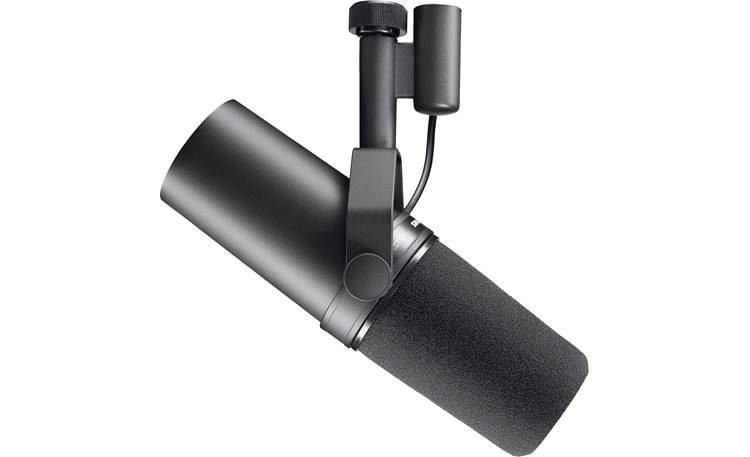
Best Vocal Microphone: For Podcasting
The Shure SM7B is one of the most renowned microphones in podcasting. It offers a refined and professional sound at a realistic price point, making it an exceptional buy for new and expert podcasters.
It is not a typical cardioid dynamic microphone. It has an even, wide-range frequency response best suited for music and speech, but it’s more frequently used for spoken word. Joe Rogan uses the SM7B as their microphone of choice.
It has also been used to record vocals on Michael Jackson’s thriller album.
The SM7B exhibits a solid and chunky but lustrous design. The enameled aluminum and steel housing feel strong in the user’s hands, not delicate. It suspends from an integrated yoke with a three-pin XLR jack and a threaded nut for mounting.
The posterior of the microphone offers some controls, including two switches for swapping between low-frequency roll-off, mid-frequency boost, and fully flat response.
Key Features
- Optimized diaphragm for increased low-end response
- large housing allowing larger rear volume behind the cartridge which also extends its low-end response
- optimized internal shock mount to reduce mic stand vibrations.
- Rugged construction
- Detachable close-talk windscreen and switch cover plate
- Bass roll-off and mid-range emphasis (presence boost) controls with graphic display of response setting
- Dynamic cartridge with flat, wide-range frequency response for extraordinarily clean and natural reproduction of both music and speech
Conclusion
The SM7B is a well-constructed microphone based on years of audio experience and manufactured for dependability and clear recordings and may be the best professional vocal microphone.
The constituents and yoke mounting system are sturdy and easy to use. There’s no requirement for an extra pop filter because it’s already included. The sound is rich and even. The mic is proficient at ignoring anything that isn’t the user’s voice.
All in all, it is a superb microphone for new and experienced podcasters.
Price: $399 USD
8. Electro-Voice RE20
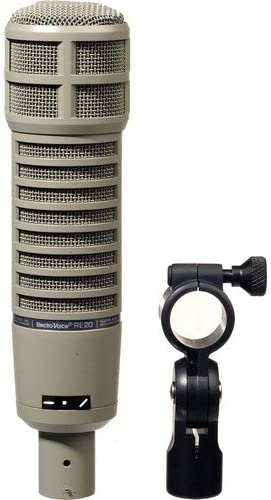
The Electro-Voice RE20 is a high-end vocal microphone. It is the finest quality dynamic microphone, optimized to record voice, that could be anything from voice-over to singing or podcasting. It offers a wide frequency range (it can “hear” more) and an exceptional transient response (the way it responds to changes in whatever it’s recording). It has a Cardioid polar pattern. It emphasizes the voice in front of it. Yet, it’s also pretty lenient.
The Electro-Voice RE20 reduces pops and sibilance while talking live, even nearby. Further safety against distortion of this type is also available, with a low-cut filter button on the mic. The steel exterior gives it a big and robust feeling. The RE20 is an XLR mic requiring a mixer, interface, or digital recorder. It doesn’t plug directly into a computer like a USB mic.
Electro-Voice states that the mic will “continue to function flawlessly in high humidity and elevated temperatures that would degrade competitive condenser microphones.”
Key Features
- Smooth, controlled, and ultra-natural tonal reproduction
- Voice-tailored frequency response
- Substantially integrated pop filters
- Bass roll-off switch
- Variable-D minimizes proximity effect
- Humbucking coil guards against line hum
- Mid-bass tone-shaping switch
- Elegant, low-reflection dark charcoal finish
Conclusion
Building on an extensive legacy of remarkable performance and dependability, RE20 has earned its place at the broadcast industry’s top. From the announce booth to the recording studio and out into the field, professionals depend on RE20. Its Variable-D design and heavy-duty internal pop filter excel for close-in voice work, whereas an internal element shock-mount decreases vibration-induced noise.

Price: $449 USD
9. Miktek MK300
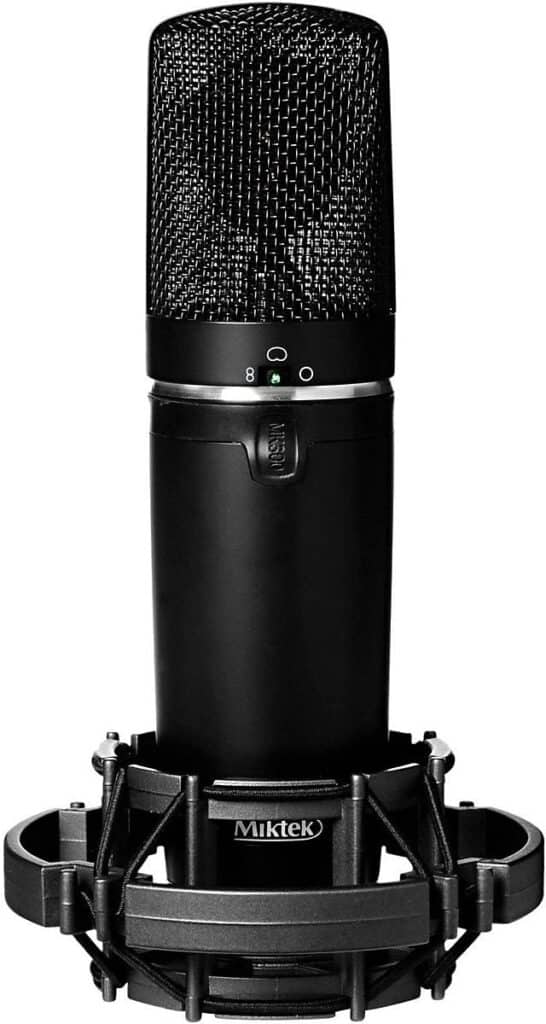
The Miktek MK300 is the first on our list of best condenser mics under 500 for its remarkable recording capabilities that help you record clean, clear and amazing vocals. This tri-pattern microphone has cardioid, bi-directional, and omnidirectional pick-up pattern capabilities that allow you to record vocals and full bands and single instruments with clarity.
Mixing after recording becomes a breeze with the MK300, which is well-suited for recording loud voices without compromising quality. Although available for budget home studio builders, it packs the functionality of high-end condenser mics commonly found in top-tier recording studios.
This model comes with a custom Miktek 1-inch capsule 0.4-micron Mylar, evaporated gold diaphragm that gives it versatility. Paired with a 48V power source, you are looking at one of the best modern microphones with a classic touch of vintage reliability and performance.
It has replaced my Blue Baby Bottle SL as my regular mic for recording vocals. Simply the best I’ve had.
Key Features
- Switchable cardioid, bidirectional, and omnidirectional polar patterns
- Highpass filter for reducing low-frequency noise and rumble
- Multi-pattern large-diaphragm FET condenser microphone
- -10dB pad for recording loud sound sources
- Sounds great on acoustic instruments, guitar amps, drums, and vocals
Conclusion
The Miktek MK300 comes with a shock mount that helps reduce the effect of mechanically transmitted noise so you can work with higher quality recordings later. We highly recommend the MK300 for beginners who want to record crisp pro-level vocals without breaking the bank. It’s not only one of the best condenser mic for vocals at this price but it also sounded great recording acoustic guitar!
Summary
My personal choices are different for different uses. If you can afford the Neumann U 87 ai and need the best quality, it’s an excellent investment for success. But you can’t go wrong with any of these for vocals. I use the Miktek MK300 and am quite happy with it.

Disclosure: davemikulskis.com is a participant in the Amazon Services LLC Associates Program, an affiliate advertising program designed to provide a means for sites to earn advertising fees by advertising and linking to Amazon.com. Some of the links above are affiliate links. This means that, at zero cost to you, I will earn an affiliate commission if you click through the link and finalize a purchase.
Related Articles
21 Best Rock Male Vocalists of All-Time Who Sang Great!
9 Best Microphones For Recording Acoustic Guitar That Sound Amazing
9 Best Studio Headphones: Amazing Music To Your Ears
9 Best Condenser Mics That Will Blow Your Mind!
9 Best Budget USB Microphones That Produce Excellent Quality
9 Best Live Vocal Microphones That Make You Stand Out!
The Ultimate Guide to the Best Vocal Mics: Condensers
Review: Miktek MK300, the Best Mic You’ve Never Heard Of
7 Best Electric Guitars For Beginners Who Want To Be Rock Stars!
7 Best Acoustic Guitars For Beginners Who Want To Start off Great!
9 Best Bass Guitars For Beginners Who Want To Be Great!
9 Best Beginner Drum Sets For Excellent Playing!


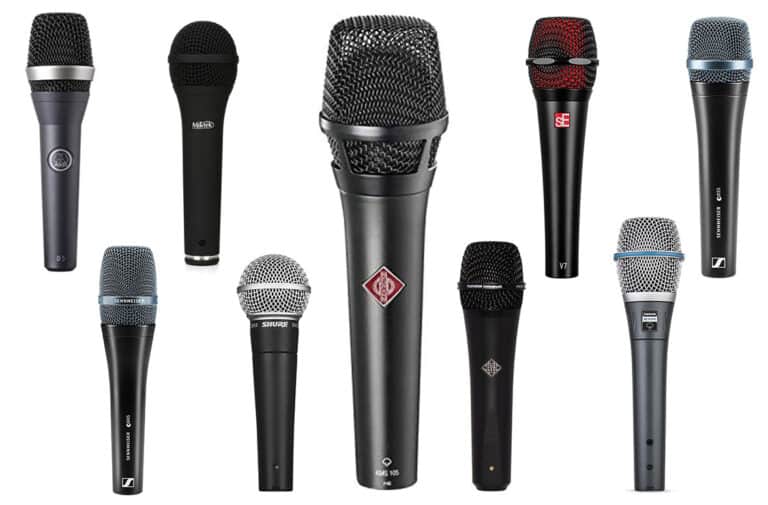

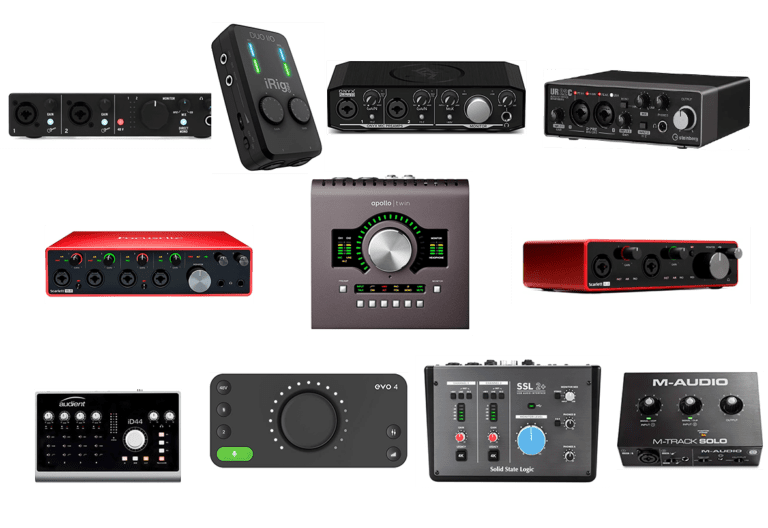
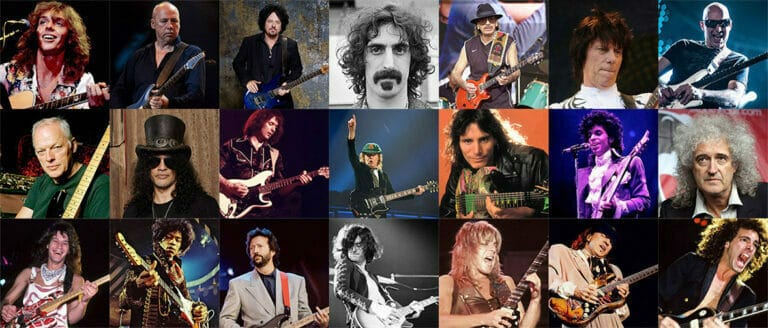

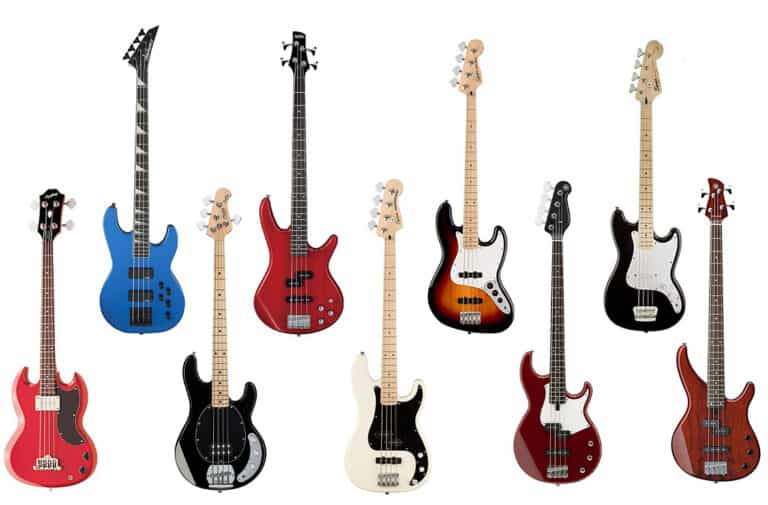
Dave your choices are top notch! I’ve done vocal recording and I use a Lawson MP 47, tube mic with multi patterns select,and love the texture that it produces on low end response. It’s a knock off of a Neumann U47 and many compare the sound very close!! For live performances I use an Earthworks Sr 40. It’s expensive but as all vocalists, you always strive for something a little more. I’ve always used stage condensers, and this one fits the bill for me. By the way you are phenomenal singer with all the tools!!
@JerrySoukal Thank you, Jerry. And, thanks for the tip on the Lawson MP 47!